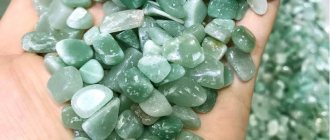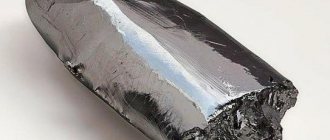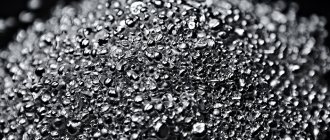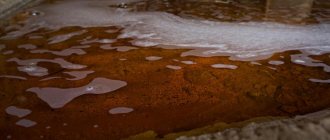The unique chemical properties of gold have given it a special place among the metals used on Earth. Gold has been known to mankind since ancient times. Since ancient times it has been used as jewelry; alchemists tried to extract the precious metal from other less noble substances. Currently, the demand for it is only growing. It is used in industry, medicine, and technology. In addition, it is acquired by both states and private individuals, using it as an investment metal.
Chemical properties of the “king of metals”
The symbol Au is used to denote gold. This is an abbreviation for the Latin name for the metal - Aurum. In the periodic table of Mendeleev it is number 79 and is located in group 11. In appearance it is a yellow metal. Gold is in the same group with copper, silver and roentgenium, but its chemical properties are closer to the platinum group metals.
Inertness is a key property of this chemical element, which is possible due to the high value of the electrode potential. Under standard conditions, gold does not react with anything except mercury. With it, this chemical element forms an amalgam, which easily disintegrates when heated to just 750 degrees Celsius.
The chemical properties of the element are such that other compounds with it are also short-lived. This property is actively used in the extraction of precious metals. The reactivity of gold increases significantly only with intense heating. For example, it can be dissolved in chlorine or bromine water, an alcohol solution of iodine and, of course, in aqua regia - a mixture of hydrochloric and nitric acid in a certain proportion. The chemical formula for the reaction of such a compound is: 4HCl + HNO3 + Au = H (AuCl4) + NO + 2H2.
The chemistry of gold is such that when heated it can react with halogens. To form gold salts, this chemical element must be reduced from an acidic solution. In this case, the salts will not precipitate, but will dissolve into liquid, forming colloidal solutions of different colors.
Despite the fact that gold does not enter into active chemical reactions with substances, in everyday life you should not allow products made from it to interact with mercury, chlorine and iodine. Various household chemicals are also not the best companion for precious metal products.
The fact is that jewelry uses an alloy of gold with other metals, and various substances, interacting with these impurities, can cause irreparable damage to the beauty of the product. If you heat gold above 100 degrees Celsius, an oxide film one millionth of a millimeter thick will appear on its surface.
Distribution of gold in nature
Gold is not very common on our planet, but it is not rare either; its content in the lithosphere is about 4.3 10-7%, and one liter of sea water contains about 4 10-9 g. A certain amount of gold is found in soil, from where plants receive it. Corn is an excellent source of natural gold for human nutrition; this plant has the ability to concentrate it in itself. Mining gold is an extremely difficult task, which is why it has such a high price. As geologists say, “gold loves solitude,” because... most often it is found in the form of nuggets, i.e. it is found in the ore in its pure form. Only in extremely rare cases are compounds of gold found with bismuth and selenium. A very small amount of it is found in igneous rocks and hardened lava. But extracting gold from them requires even more work, and its content is very low. Therefore, the method of extraction from igneous rocks is not used due to its unprofitability. The main gold reserves are concentrated in Russia, South Africa and Canada.
Other features of the precious metal
Gold is one of the heaviest metals known. Its density is 19.3 g/cm3. An ingot weighing 1 kilogram has very small dimensions, 8x4x1.8 centimeters. This is the standard size of a bank gold bar of this weight. It is comparable to the size of a regular credit card, although the bar is slightly thicker.
Only a few elements are heavier than gold: plutonium, osmium, iridium, platinum and rhenium. But their content in the earth’s crust, even taken together, is much less than this precious metal. Moreover, plutonium (chemical symbol Pu, not to be confused with Pt - this is the symbol of platinum) is a radioactive element.
The chemical composition of gold provides its physical properties. So, the main properties of this metal that make it unique include:
- Malleability, plasticity, ductility. It is very easy to flatten or stretch. So, from just one gram of gold you can get a wire 3 kilometers long, and the area of thin sheets obtained from 1 kilogram will be 530 square meters. Ultra-thin sheets of gold foil are called “gold leaf.” They cover, for example, church domes and the interior decoration of palaces. Thanks to its plasticity, a small amount of yellow metal can cover gigantic areas.
- Softness. High-grade gold is so soft that it can be easily scratched even with a fingernail. This is why bullion in jars is sold in sealed plastic packaging. If even one small scratch is noticed on it, it will be considered defective. In order to make gold more durable, other metals are added to it when making products. This property has ensured the high popularity of the king of metals in the jewelry industry.
- High electrical conductivity. Due to this chemical property, gold is highly valued in electrical engineering and industry. Only silver and copper conduct electricity better than it. At the same time, gold hardly heats up: in terms of thermal conductivity, diamond, silver and copper are higher than it. Together with its property of oxidation resistance, gold is an ideal substance for the manufacture of semiconductors.
- Reflection of infrared light. The finest gold plating applied to the glass does not transmit infrared radiation, leaving the visible part of the spectrum. This property is actively used in astronautics when it is necessary to protect the eyes of astronauts from the harmful effects of the sun. Spraying is often used in the mirror system of high-rise buildings to reduce the cost of cooling rooms.
- Resistant to corrosion and oxidation. Ingots that are stored in accordance with the rules are practically not subject to any chemical influence even when exposed to air. So the greater preservation of gold ensured its high popularity.
Atomic structure and physical properties
In the table, gold is located in the sixth period in the copper subgroup of group 11. Its letter designation is Au. The element has an atomic number of 79. The nucleus of a metal atom contains 79 protons and 117 neutrons. There are 79 electrons in the six energy levels of an atom. The natural element exists in the form of a chemically stable isotope 197Au. The rest are unstable and are possible only in a nuclear reactor.
The distribution of electrons over orbitals in the electronic formula of gold is 1s22s22p63s23p63d104s24p64f145s25p65d106s1. In its compounds, the metal exhibits valency I. This is due to the presence of one unpaired electron. But the element is also characterized by valence II.
Gold belongs to the group of transition metals. An absolutely pure substance is characterized by a bright yellow color. If the mineral contains copper impurities, then it may have a reddish tint. The chemical element is characterized by a face-centered cubic crystal lattice.
Main physical characteristics of gold:
- melting point - 1064.18 °C;
- boiling point - 2856 °C;
- atomic mass - 196.96655;
- density - 19.3 g/cm3;
- molar volume - 10.2 cm3/mol;
- hardness on the Mohs scale - 2.5.
The substance is characterized by plasticity and flexibility. Gold is the softest of all metals and is easy to work with. Products made from this high-quality substance can be bent and damaged, so they must be protected from any mechanical damage. When making cutlery, manufacturers add additional alloys to gold, which increase the strength of the items. The liquid substance is volatile and can evaporate even before its melting point.
The mineral is highly resistant to chemical reactions and processes. It is an excellent conductor that quickly transports electric current and thermal energy. The metal is easily polished and after processing acquires a soft shine. A thin plate made of gold is capable of transmitting light. Since the temperature of the substance drops, it can be used to tint windows.
Gold mining method
Gold is a fairly rare element on Earth. Its content in the earth's crust is low. It is mainly found in the form of placers in the native state or in the form of ore and occasionally occurs in the form of minerals. Sometimes gold is mined as a by-product in the development of copper or polymetallic ores.
Humanity knows many ways to extract this noble metal. The simplest is elutriation, that is, the separation of gold ore from waste rock using a special technical process. However, this method involves large losses, since the technology is far from perfect. The mechanical method of extracting gold ore was replaced by chemistry. Alchemists, and after them chemists, received many methods for isolating the desired metal from a rock, among them the most common:
- amalgamation;
- cyanidation;
- electrolysis.
Electrolysis, discovered in 1896 by E. Wohlwill, has become widespread in industry. Its essence lies in the fact that anodes consisting of a gold-containing substance are placed in a bath with hydrochloric acid solution. A sheet of pure gold is used as a cathode. During the process of electrolysis (passing current through the cathode and anode), the desired substance is deposited on the cathode, and all impurities precipitate. Thus, the chemical properties of the precious metal help to obtain it on an industrial scale with virtually no losses.
Where is gold mined?
Most gold mining is now done in the Republic of South Africa. In one year, experts can find more than five hundred tons of gold. For such a cosmic result, they have to dig through more than seven hundred tons of other various rocks. It also takes an incredible amount of water to wash the gold ore.
Gold mining is also carried out in China, the USA, Australia and Peru. Russia also has gold metal, but not so much. Chukotka, Krasnoyarsk Territory and Amur Region are specialized for its extraction.
Alloys with other metals
Noble metal alloys are formed for two purposes:
- Change the mechanical properties of gold, make it stronger or, conversely, more brittle and malleable.
- Save precious metal reserves.
Various additions to gold are called alloys. The color and properties of the alloy depend on the chemical formula of its components. Thus, silver and copper significantly increase the hardness of the alloy, which makes it possible to use it for making jewelry. But lead, platinum, cadmium, bismuth and some other chemical elements make the alloy more brittle. Despite this, they are often used to produce the most expensive jewelry, as they significantly change the color of the product. The most common alloys:
- green gold - an alloy of 75% gold, 20% silver and 5% indium;
- white gold is an alloy of gold and platinum (in a ratio of 47:1) or gold, palladium and silver in a ratio of 15:4:1.
- red gold - an alloy of gold (78%) and aluminum (22%);
- an alloy of gold and silver in a ratio of 3:1 (interestingly, an alloy in any other proportion will become white, and these alloys are called by the general term “electron”).
Depending on the amount of gold in the alloy, its sample is determined. It is measured in ppm and is indicated by a three-digit number. The amount of the required metal in each alloy is strictly regulated by the state. In Russia, only 5 samples are officially accepted: 375, 500, 585, 750, 958, 999. The sample numbers mean that this is exactly how many measures of gold there are per 1000 measures of the alloy.
In other words, a 585-carat bar or product contains 58.5% gold. Gold of the highest standard, 999, is considered pure. Only chemistry uses it for its needs, since this metal is too fragile and soft. 750 standard is the most popular in the jewelry industry. Its main components are silver, copper, platinum. The product must have a mark - a digital sign indicating the sample.
Where is the mined gold located?
Gold reserve storage
According to statistics, almost all the gold found, specifically 90%, is in the bank. It can also be kept by private individuals under the guise of jewelry. Only 10% of all mined metal remains for industry.
In the world list in terms of the volume of gold held in state reserves, the leader is the United States. As of 2021, the US gold reserve is more than 8.1 thousand tons. Russia, with gold reserves of about 2.3 thousand tons, is in 5th place in this ranking.
Counterfeiting gold jewelry
If something sells well, it's a sign that something can be faked to match it. Counterfeiting of gold is perhaps one of the most common fraudulent schemes today, which is ensured by the high cost of the precious metal. Most often, “white gold” is counterfeited, passing off ordinary high-grade silver as an alloy with platinum. But an experienced buyer will always distinguish one precious metal from another.
Another chemical element that is ideal for counterfeiting gold is tungsten. Light bulb hairs, electrodes, and so on are made from it. This chemical element has a density similar to gold, so its weight is practically indistinguishable from the noble metal.
In addition, sometimes the hallmark is faked. If there are doubts about the quality of the product or if the hallmark mark does not match the hallmark number indicated in the accompanying documents, it is better to refuse to purchase such a product.
Receipt
Gold is produced using its basic physical and chemical properties: Presence in nature in its native state, the ability to react with only a few substances (mercury, cyanide). With the development of modern technologies, chemical methods are becoming increasingly popular.
Flushing
The washing method is based on the high density of gold, which washes out minerals less dense than gold (which is almost all the minerals in the earth's crust) in a stream of water, and the metal is concentrated in the heavy fraction, sand, which consists of high-density minerals called concentrate. This process is called mucus flushing or slimming. In small quantities this can be done manually using a rinsing bowl. This method has been used since ancient times and is still used by miners to extract small deposits of soap, but its main use is to find deposits of gold, diamonds and other precious metals.
Flushing is used to develop large deposits of soapy water, but special technical equipment is used: excavators and washing equipment. With the exception of gold, the resulting slurries contain a number of other dense minerals from which the metal is extracted, for example by smelting.
All placer gold deposits are mined by panning and their use is limited to primary deposits. To do this, the stone is crushed and then washed. This method cannot be used in deposits with dispersed gold, where it is distributed in the rock in such a way that after crushing it is not separated into individual grains and is washed along with other minerals during washing. Unfortunately, during washing, not only small gold is lost, which is easily washed off the washing deck, but also large nuggets, which, due to their hydraulic size, cannot easily fit into the cells of the carpet. Therefore, it is necessary to ensure that there are no large rolling debris left on excavators and industrial equipment - these could be nuggets.
Merger
The amalgamation method is based on the ability of mercury to form alloys - amalgams with various metals, including gold. In this method, moistened, crushed rock was mixed with mercury and further crushed in mills - running bowls. The gold amalgam (and its associated metals) was recovered from the resulting sludge by washing, after which the mercury was distilled from the collected amalgam and reused.
It is known that the largest amount of mercury was acquired in the American colonies of Spain starting from the 16th century BC: This became possible due to the presence of a huge mercury deposit in Spain - Almadena. In later times, the external fusion method was used, in which crushed gold-bearing rock was washed through processing sluices lined with copper sheets coated with a thin layer of mercury. The merger method is applicable only to deposits with a high gold content or already at the time of its enrichment. Nowadays it is used very rarely, mainly by miners in Africa and South America.
Cyanidation
Gold is soluble in solutions of hydrocyanic acid and its salts, and this property has led to a number of extraction methods by cyanidation of ores.
The cyanidation method is based on the reaction of gold with cyanides in the presence of atmospheric oxygen: crushed gold-bearing rock is treated with a dilute (0.3-0.03%) solution of sodium cyanide, gold from the resulting solution of sodium cyanide Na[Au(CN)2] is precipitated either with zinc dust or special ion exchangers resins.
The cyanidation method was initially used in large enterprises, where rock was crushed and cyanidation was carried out in special vats. However, advances in technology have led to the heap leaching method, which involves preparing a waterproof area, pouring ore onto it, and irrigating it with cyanide solutions, which seep through the rock to dissolve the gold. Then they go to special sorption columns, where they put gold, and the recovered solution is sent back to the heap.
The cyanidation method is limited by the mineral composition of the ores; it is not applicable if the ore contains a large amount of sulfides or arsenides, since cyanides react with these minerals. Therefore, cyanidation involves the processing of low-sulfur ores or ores from an oxidation zone in which sulfides and arsenides are oxidized by atmospheric oxygen.
Complex multi-stage technologies are used to extract gold from sulfide ores. Gold extracted from deposits contains various impurities, so it undergoes special highly purified processes that are carried out at refineries.
In 2005, Rick Munarriz wondered whether it was better to invest in Google, which owns the search engine of the same name, or in gold. At that time, the price of 1 Google share and 1 ounce of gold on the stock exchange was the same. At the end of 2008, Google closed at $307 per share and gold at $866 per ounce.
Gold is a critical element of the global financial system because it is non-corrosive, has many technical uses, and has low reserves. Gold is almost never lost in historical disasters, but only accumulates and melts. Currently, the World Bank's gold reserves are estimated at 32 thousand tons of gold (if you melt all this gold together, you will get a cube with a side of only 12 meters).
Gold has long been used as money by many nations. Gold coins are the best-preserved artifacts of the ancient world. However, gold coins became established as monopoly money only in the 19th century. Before World War I, all world currencies were based on the gold standard (the period 1870-1914 is called the “Golden Age”). At this time, paper bills served as gold certificates. They were freely exchanged for gold.
How to distinguish a fake?
There are several ways to distinguish a genuine product from a counterfeit. It should be noted that using only one test does not guarantee the accuracy of the result. It is better to check on several parameters. So, experienced jewelers use the following methods to distinguish gold from fake:
- Check softness. Real yellow metal is very soft. If you bite into it, it will leave a mark. This is exactly how you can spot a fake. Alloys with a minimum content of noble metal are hard.
- Check the sound. Real gold jewelry rings softly and easily. But you shouldn't rely on hearing alone. Different impurities distort the sound in different ways.
- They drip with iodine. If the product contains a large proportion of the desired metal, then a drop of iodine placed on the surface of the object will turn black. Otherwise, it will turn white.
- They draw on the tiles. Since the density of gold is higher than tile, it should leave a characteristic golden mark on it. If it is a fake, then the mark will remain on the product. Also, traces of gold dust will remain on the skin if the product is thoroughly rubbed, for example, on your hand.
- Weigh on special scales. If the metal density is less than declared, then the weight of the product will be less.
- Scrape the back of the object. This is done in order to find out whether ordinary copper or tungsten is hidden under a layer of gold.
Potential buyers should be wary of the following points:
- lack of documentation;
- discrepancy between the mark and the hallmark declared in the documents;
- corrections in documents;
- erased hallmark;
- hallmark of the Soviet period;
- unusual color of the product.
If something incomprehensible confuses you and there are any suspicions, this is a sure sign that you should first show the product to a professional, an appraiser or a pawnshop employee, and only then make a decision to purchase.
What have we learned?
Gold is a valuable metal and is widely used. The article briefly describes the characteristics of the metal and its location in nature. Gold is used in jewelry, industry, dentistry, in the production of medicines, and in the treatment of cancer, which can be discussed in a report or essay on the topic “Gold. Properties and Application" for 4th grade.
Previous
The world around usClimate in the taiga - briefly for children in winter and summer (4th grade, the world around us)
Next
The world around usEcological problems of deserts and semi-deserts in Russia briefly (grade 4, the world around us)
Banking sector
In ancient times, gold was used only for making jewelry. Further, it became an excellent means of saving and accumulating wealth. Those who knew how to get gold did not need to think about tomorrow. After all, the precious metal was quite expensive at all times.
Today, gold is widely used to make coins. But the precious metal does not enter monetary circulation. Coins or bullion are held in financial institutions as savings. Investing in precious metals is at the peak of popularity today. In this way, you can not only save money, but also increase it.










